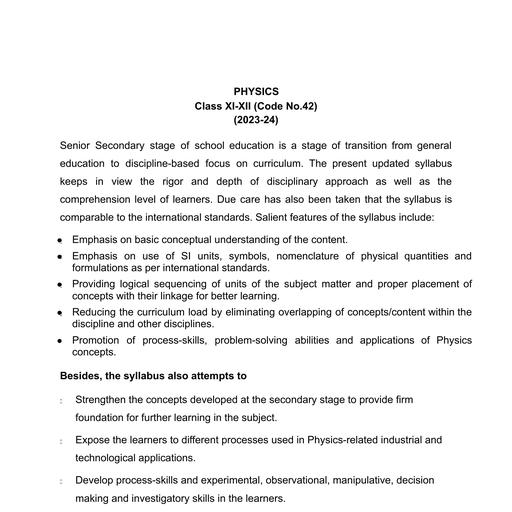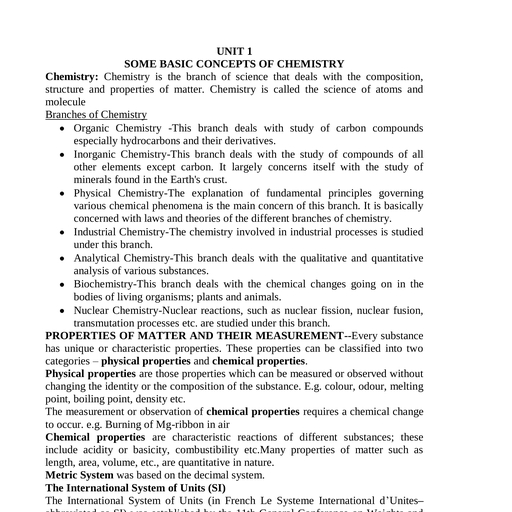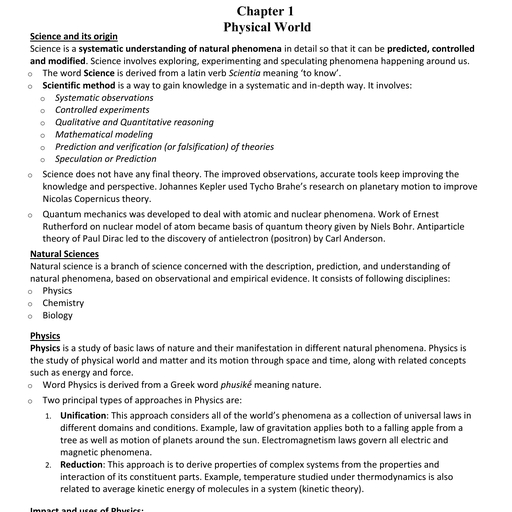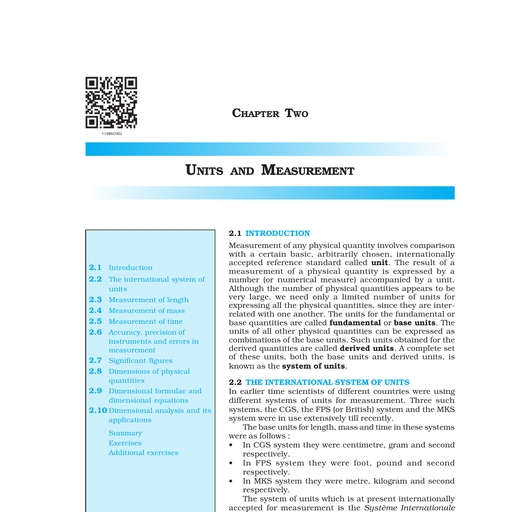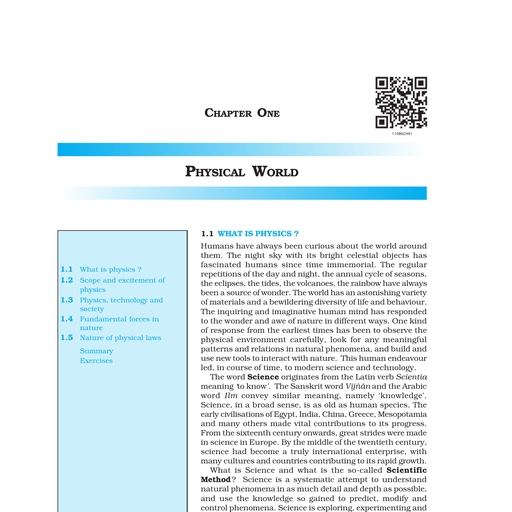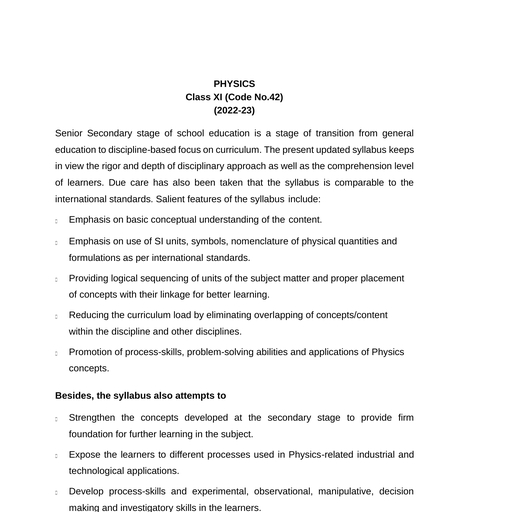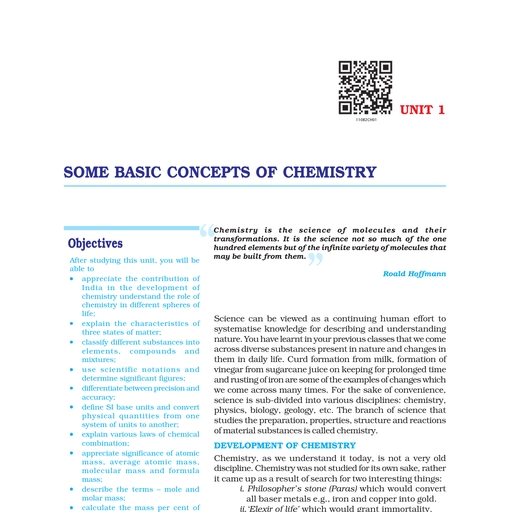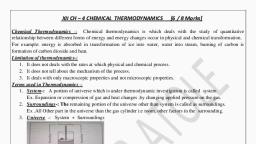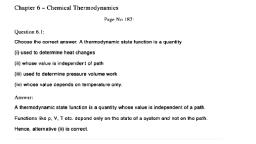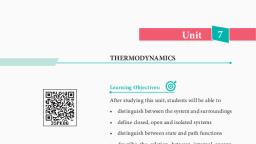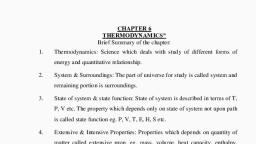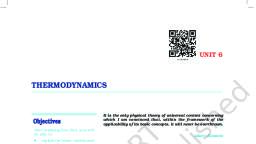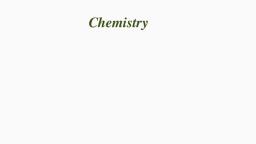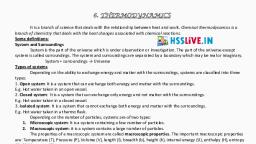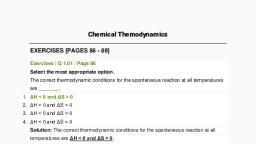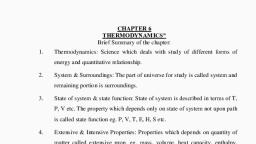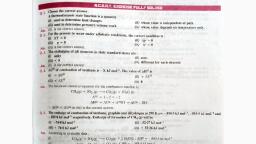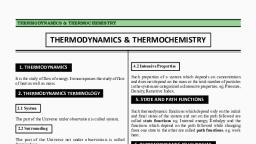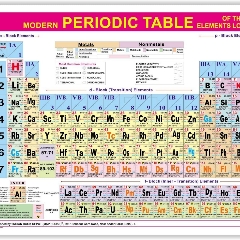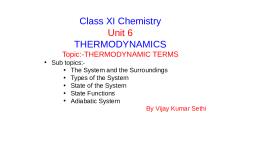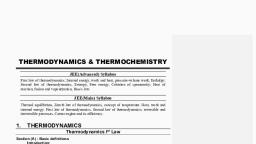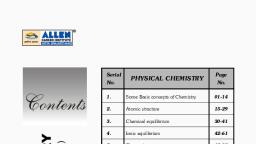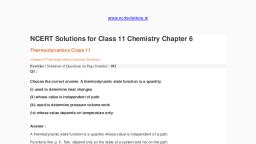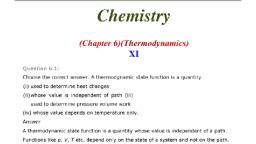Page 1 :
CHAPTER, , 2, , Thermodynamics, Recap Notes, Thermodynamics : It is a branch of science, which deals with the study of interconversion, of different forms of energies and their, quantitative relationships., Some basic terms :, X System : It is the part of universe under, investigation where energy changes can, be regulated and studied., X Surroundings : Rest part of the universe, which can interact with the system or can, influence the properties of the system is, called surroundings., X Boundary : A real or imaginary surface, that separates the system from the, surroundings is known as boundary., A boundary can be rigid or non‑rigid, (movable), permeable or impermeable,, adiabatic (non‑conductor of heat) or, diathermic (conductor of heat)., Types of system :, X Open system : A system which can, exchange mass as well as energy with the, surroundings., X Closed system : A system which can, exchange energy but not mass with the, surroundings., X Isolated system : A system which can, neither exchange energy nor mass with, the surroundings., X State functions : Properties which are, used to define a particular thermodynamic, state and are independent of the path by, which the state is attained are called state, functions. e.g., pressure, mass composition,, volume, temperature, internal energy,, , X, , entropy, Gibbs free energy, etc., Path functions : Variables whose values, depend upon the path followed by the, system in attaining that state, are known, as path functions., , Types of thermodynamic processes :, X Isothermal process : Temperature of, the system remains constant (DT = 0)., X Isobaric process : Pressure of the, system remains constant (DP = 0)., X Isochoric process : Volume of the, system remains constant (DV = 0)., X Adiabatic process :, The system does not, exchange heat with, the surroundings (i.e.,, q = 0)., X Reversible process : Direction may be, reversed at any stage., X Irreversible process : Proceeds only in, one direction and cannot be reversed., X Cyclic process : System returns to its, original state after a number of steps. For, such a process, DU = 0 and DH = 0., X Exothermic process : Accompanied by, the evolution of heat., X Endothermic process : Accompanied by, the absorption of heat., Internal Energy (U ) : Sum of various forms, of energy such as rotational, vibrational,, translational, kinetic, coulombic, nuclear, etc., is known as internal energy., X It is a state function., X It is extensive property and depends only, on temperature.
Page 2 :
Work (W) : Work is a mode of energy transfer, from or to the system to make some net, changes in the state of the system. No work, is being done when system is in equilibrium., Work = Force × displacement = F × l, X Electrical work : It is the work involved, in reactions involving ions., Electrical work done = EMF × quantity of, �electricity., X Pressure-volume work : It is the work, done involved in expansion or compression, of the gases against external pressure., Work = Pressure × area × l = Pext × DV, where, Force = Pressure × area;, area × l = volume and DV is change in, volume i.e., DV = (V2 – V1)., , dw = – (Pext – dP)dV, but as dP is very small thus, on ignoring, dPdV, we get dw = –Pext dV = – PdV, – The overall work done in an isothermal, reversible expansion of the ideal gas, from V1 to V2 is as follows :, wrev = −, , Applications :, X Isothermal reversible expansion of, an ideal gas : Consider a gas enclosed in, a cylinder fitted with a frictionless piston., During the expansion volume increases, and pressure decreases. In the beginning, external pressure Pext is equal to the internal, pressure of the gas therefore, the piston, does not move. If the external pressure is, decreased by dP, the gas expands reversibly, and the piston moves through a distance dP., The work done by the gas in an infinitesimal, expansion is thus given by, , ∫, , PdV, , V1, , From ideal gas equation, P = RT/V, �, Substituting the value of P in the, above integral equation,, w = − RT, , V2, , ∫, , V1, , V, dV, = − RT ln 2, V, V1, , For n moles, w = − nRT ln, , Heat (q) : Heat is a mode of energy transfer, between system and surrounding because of, difference in temperature between them. It, is measured in terms of calories. SI unit of, heat is joule., First law of thermodynamics : This is the, law of conservation of energy which states, that energy can neither be created nor be, destroyed, although it can be converted from, one form to another., X The total energy of the universe remains, constant., X DE or DU = q + w or q = DU – w, X q and w are not state functions but, DU = (q + w) is a state function., X Sign convention :, – Heat absorbed by the system = +ve, – Heat evolved by the system = –ve, – Work done on the system = +ve, – Work done by the system = –ve, , V2, , Q, , P1V1 = P2V2, , \, , w = − nRT ln, , P1, P2, , V2, V1, , = −2.303 nRT log, , P1, P2, , –, , X, , X, , The work done during an isothermal, reversible compression can be given, as :, P, w = 2.303 nRT log 1, P2, �Thus, opposite to the first case where,, work done in isothermal compression, has exactly the same value with, positive sign., Free expansion : Expansion of a gas in, vacuum (Pex = 0) is called free expansion., No work is done during free expansion, of an ideal gas whether the process is, reversible or irreversible., i.e., DU = q – Pex DV, At constant V, DU = qV, Isothermal and free expansion of an, ideal gas :, – For isothermal expansion of an ideal, gas into vacuum; w = 0 since, Pex = 0, – For isothermal irreversible change;, q = –w = Pex(Vf – Vi), – For isothermal reversible change;, Vf, q = –w = 2.303 nRT log, Vi, –, , For adiabatic change; q = 0, DU = wad
Page 3 :
Enthalpy (H) : Total heat content of the, system at constant pressure is known as its, enthalpy., X It is an extensive property., X It is state function., X Its absolute value can not be determined., X Mathematically it is given as, H = U + PV, X If H2 is the enthalpy in final state and H1, in initial state, then, ∆H = ( H2 − H1 ) = ∆U + P ∆V, X, , X, , X, , X, , For exothermic reaction (i.e., heat released, during the reaction), DH is negative i.e.,, DH < 0. Whereas for endothermic reaction, (i.e., heat absorbed during the reaction),, DH is positive i.e., DH > 0., According to first law of thermodynamics,, q = DU – w; where, w is the pressurevolume work done by the system., Q w = –PDV, At constant volume (DV = 0) then, w = 0, \ qv = ∆U, At constant pressure, (DP = 0) then,, w = –PDV, qp = DU + PDV, Comparing this equation with equation of, enthalpy change, we get, qp = DH, , Relationship between DH and DU :, X As PDV = DngRT, where, Dng = number of moles of gaseous, products – number of moles of gaseous, reactants., \ DH = DU + DngRT or qp = qv + DngRT, – When Dng = 0, then DH = DU, – When Dng > 0, then DH > DU, – When Dng < 0, then DH < DU, – For a reaction involving only solids, and liquids, Dng = 0, thus, DH = DU., Extensive and intensive properties :, X Extensive properties : The properties, which depend upon the amount of matter, contained in a system are called extensive, properties. For example, mass, volume,, enthalpy, entropy, free energy, heat, capacity, etc., X Intensive properties : The properties, which do not depend upon the amount of, , matter present in the system but depend, only on the nature of the matter are, called intensive properties. For example,, temperature, pressure, density, refractive, index, viscosity, specific heat, freezing, point, boiling point, etc., Enthalpy of reaction : It is defined as, the change in enthalpy, or the amount of, heat evolved or absorbed when the number, of moles of reactants reacts completely to, give the products as given by the balanced, chemical equation., C(g) + O2 (g) → CO2 (g); Dr H = –393.5 kJ mol–1, CH4(g) + 2O2(g) → CO2(g) + 2H2O(g);, X, , �, Dr H = –890.3 kJ mol–1, Enthalpy of formation : It is the change, in enthalpy when one mole of a substance, is formed directly from its constituent, elements, e.g.,, C(s) + 2H2(g) → CH4(g); Df H = –748 kJ mol–1, , X, , X, , X, , X, , Enthalpy of combustion : It is the, change in enthalpy when one mole of a, substance is completely burnt in oxygen,, e.g.,, C(s) + O2(g) → CO2(g);�DcH = –393.5 kJ mol–1, DcH is always negative as heat is always, evolved during combustion., Enthalpy of solution : It is the change, in enthalpy when one mole of a substance, is dissolved in excess of water so that, further dilution does not involve any heat, change, e.g., NaCl(s) + aq. → NaCl(aq);, DsolnH = +5.0 kJ mol–1, Enthalpy of neutralisation : It is, the change in enthalpy when one gram, equivalent of an acid is completely, neutralised by 1 g equivalent of a base in, dilute solutions, e.g.,, HCl(aq) + NaOH(aq) → NaCl(aq) + H2O(l);, �, DneuH = –57.1 kJ mol–1, Enthalpy of fusion : It is the change, in enthalpy when one mole of a solid is, completely converted into liquid state at, its melting point, e.g.,, H2O(s) → H2O(l) at 0 °C or 273 K;, �, DfusH = +6.0 kJ mol–1
Page 4 :
X, , X, , X, , X, , Enthalpy of vapourisation : It is the, change in enthalpy when one mole of a, liquid is completely converted into its, vapours at its boiling point, e.g.,, H2O(l) → H2O(g) at 373 K;, DvapH = +40.6 kJ mol–1, Enthalpy of sublimation : It is the, change in enthalpy when one mole of a, solid is directly converted into vapours,, e.g.,, DsubH of iodine is +62.4 kJ mol–1., Also, DsubH = DfusH + DvapH, Enthalpy of atomization : It is the, change in enthalpy on breaking one mole, of bonds completely to obtain atoms in the, gas phase, e.g., CH4(g) → C(g) + 4H(g);, DaH = 1665 kJ mol–1, Bond enthalpy : It is the change in, enthalpy associated with breaking and, making of chemical bonds, e.g.,, Cl2(g) → 2Cl(g) ; DbondH = 242 kJ mol–1, , Hess’s law of constant heat summation :, It state that the total amount of heat change, in a chemical reaction is same whether the, reaction takes place in one step or in number, of steps., Q, A, q1, , D, B, , q2, , C, , q3, , Q = q1 + q2 + q3, X, , X, , Applications of Hess’s law : The most, important application of Hess’s law is, in the calculation of heat changes for, those reactions in which experimental, determination is not possible., The thermochemical equations can be, treated as algebraic equations which, can be added, subtracted, multiplied or, divided., , Lattice enthalpy : Hess’s law can be used, to determine lattice energy which may be, defined as the amount of heat liberated when, the requisite amounts of ions in the gaseous, state combine to produce 1 mole of crystal, lattice. For example, lattice energy of NaCl, crystal can be determined in the following, steps :, , Na(s) +, , Step 1, , 1, 2, , Cl2(g) → NaCl(s), , Step 2, Cl(g), , Na(g), Step 3, , Step 5, , Step 4, , Na+(g) + Cl–(g), Born–Haber cycle, X, , X, , X, , X, , X, , Step 1 : Conversion of Na metal to, gaseous atoms., Na(s) → Na(g) ;� D1H = Sublimation energy, Step 2 : Dissociation of Cl2 molecules to, Cl atoms., Cl2(g) → 2Cl(g) ;� D2H = Dissociation energy, Step 3 : Conversion of gaseous metal, atom to metal ions by losing electron., +, Na(g) → Na(g), + e– ; D3H = Ionization energy, Step 4 : Cl(g) atoms gain an electron to, form Cl– ions., Cl(g) + e– → Cl–(g) ;� D4H = Electron affinity, Step 5 : Na+(g) and Cl–(g) combine together, to form the crystal lattice., Na+(g) + Cl–(g) → NaCl(s) ; D5H = Lattice, energy, Applying Hess’s law we get,, D1H + 1/2 D2H + D3H + D4H + D5H = Df H, �(NaCl), On putting the various known values, we, can calculate the lattice energy., , Spontaneity :, X Spontaneous process : The process, which takes place by itself or after proper, initiation under a given set of conditions, is known as spontaneous process. All, natural processes are spontaneous and, cannot be reversed without the help of, an external agency. Hence, spontaneous, processes are irreversible. e.g., flow of, heat from hot reservoir to cold reservoir,, flow of water down the hill, dissolution of, common salt in water, diffusion of gases, from high pressure to low pressure, etc., X Non-spontaneous process : The process, which can neither take place by itself nor, by initiation, is called non-spontaneous, process. e.g., flow of heat from cold
Page 5 :
positive. Spontaneity of a process is, decided by net resultant effect of energy, and entropy., q, If DSSystem = rev , then, DSSurrounding =, T, q, − rev, T, , reservoir to hot reservoir, flow of water, up the hill, dissolution of sand in water,, diffusion of gas from low pressure to high, pressure, etc., Factors affecting spontaneity of a, reaction :, X Energy or enthalpy : Every system, tends to have minimum energy just in, order to acquire maximum stability. Thus,, the reaction which results in products of, lesser energy i.e., exothermic reactions, must be spontaneous. e.g.,, N2 + 3H2 → 2NH3 ; DH = – 92.4 kJ mol–1, H2O(l) → H2O(g) ; DH = +44 kJ mol–1, X Entropy : Every system tends to have, maximum randomness just in order to, acquire maximum stability. An increase, in entropy or randomness (i.e., positive, DS) favours the spontaneity of a reaction., e.g., spreading of a drop of ink in a beaker, filled with water is a spontaneous process,, where randomness is increasing, i.e., DS, is positive., – For a reversible process at equilibrium,, DS = 0, – For a process to be spontaneous in, isolated system, DS should be positive., – For a process in open system, entropy, of surrounding should be positive., \ DSTotal = DSSystem + DSSurrounding, – For a process to be spontaneous in, such condition,, DSTotal = DSSystem + DSSurrounding > 0, �, (i.e., positive), – For reversible processes,, DSSystem + DSSurrounding = 0, – For irreversible process,, DSSystem + DSSurrounding > 0, Therefore, it can be said that for all, spontaneous processes, DSTotal must be, , X, , X, , Gibbs energy : Gibbs energy change is, given as, DG = DH – TDS, This expression combines both factors i.e.,, DH and DS of spontaneity., It means, DG is resultant of two factors :, – For a reaction to be spontaneous, DG, must be negative., – If DG = 0, process is in equilibrium., – If DG = positive, process is nonspontaneous., Gibbs energy change and equilibrium :, Gibbs energy change, DrG° is related to the, equilibrium constant of the reaction as, DrG° = –2.303 RT log K, , Effect of temperature on spontaneity of, reactions, Description*, DrH° DrS°, DrG°, spontaneous at all, –, +, –, temperatures, spontaneous at low, –, –, – (at low T ), temperature, non-spontaneous at, –, –, + (at high T ), high temperature, non-spontaneous, +, +, + (at low T ), at low temperature, spontaneous, at, +, +, – (at high T ), high temperature, non-spontaneous, +, –, + (at all T ), at all temperatures, *The term low temperature and high temperature are, relative. For a particular reaction, high temperature could, even mean room temperature.
Page 6 :
Practice Time, , 1. System in which there is no exchange of, matter, work or energy from surroundings is, (a) closed, (b) adiabatic, (c) isolated, (d) isothermal., 2. Five moles of a gas is put through a series, of changes as shown graphically in a cyclic, process. The processes A → B, B → C and, C → A respectively are, , (a), (b), (c), (d), , isochoric, isobaric, isothermal, isobaric, isochoric, isothermal, isothermal, isobaric, isochoric, isochoric, isothermal, isobaric, , 3. Which one of the following statements is, false?, (a) Work is a state function., (b) Temperature is a state function., (c) Change in the state is completely defined, when the initial and final states are specified., (d) Work appears at the boundary of the system., 4. The correct figure representing isothermal, and adiabatic expansions of an ideal gas from a, particular initial state is, (a), , (b), , Isothermal, , (c), , (d) none of these., , Adiabatic, , 5. The temperature of the system increases, during an, (a) isothermal expansion, (b) adiabatic compression, (c) adiabatic expansion, (d) isothermal compression., 6. For which of the following reactions will DH, be equal to DU?, (a) H2(g) + I2(g) → 2HI(g), 1, (b) H2(g) + O2(g) → H2O(l), 2, (c) 2SO3(g) → 2SO2(g) + O2(g), (d) 2NO2(g) → N2O4(g), 7. In thermodynamics, which one of the, following properties is not an intensive property?, (a) Pressure, (b) Temperature, (c) Volume, (d) Density, 8. Which of the following reactions corresponds, to the definition of enthalpy of formation ?, (a) C(g) + O2(g), CO2(g), (b) C(s) + O2(l), CO2(g), (c) C(s) + O2(g), CO2(g), (d) C(l) + O2(s), CO2(g), 9. Which of the following statements is correct?, (a) �The presence of reacting species in a covered, beaker is an example of open system., (b) �There is an exchange of energy as well, as matter between the system and the, surroundings in a closed system., (c) �The presence of reactants in a closed vessel, made up of copper is an example of a closed, system., (d) �The presence of reactants in a thermos flask, or any other closed insulated vessel is an, example of a closed system., 10. Enthalpy of combustion of carbon to CO2 is, –393.5 kJ mol–1. What amount of heat will be, released upon formation of 35.2 g of CO2 from, carbon and oxygen gas?
Page 7 :
(a) 214.8 kJ, (c) 414.8 kJ, , (b) 314.8 kJ, (d) 514.8 kJ, , 11. Work done in reversible isothermal process, is given by, nR, V, (a) –2.303 nRT log 2 (b), (T2 − T1 ), (γ − 1), V1, (c) –2.303 nRT log, , V1, V2, , (d) +2.303 nRT log, , V2, V1, , 12. The standard heat of formation at 298 K for, CCl4(g), H2O(g), CO2(g) and HCl(g) are –25.5, –57.8,, –94.1 and –22.1 kcal per mole respectively. Then, DH° at 298 K for the reaction, CCl4(g) + 2H2O(g) → CO2(g) + 4HCl(g) is, (a) – 32.9 kcal, (b) – 41.4 kcal, (c) – 99.2 kcal, (d) – 323.6 kcal, 13., (a), (b), (c), (d), , In endothermic reactions,, reactants have more energy than products, reactants have less energy than products, reactants and products have same energy, reactants have lower temperature than, products., , 14. When 1 M H2SO4 is completely neutralised, by sodium hydroxide, the heat liberated is, 114.64 kJ. What is the enthalpy of neutralisation?, (a) +114.64 kJ, (b) –114.64 kJ, (c) –57.32 kJ, (d) +57.32 kJ, 3, 15. In the reaction, S + O2, SO3 + 2x kJ, 2, 1, and SO2 + O2, SO3 + y kJ., 2, Heat of formation of SO2 is, (a) x + y, (b) x – y, (c) 2x – y, (d) 2x + y, , 16. For one mole of NaCl(s) the lattice enthalpy is, , (a) –788 kJ/mol, (c) +788 kJ/mol, , (b) +878 kJ/mol, (d) –878 kJ/mol, , 17. The heat of neutralization is maximum, when, (a) sodium hydroxide is neutralized by acetic, acid, (b) ammonium hydroxide is neutralized by, hydrochloric acid, (c) sodium hydroxide is neutralized by formic, acid, (d) sodium hydroxide is neutralized by, hydrochloric acid., 18. Which of the following processes is a nonspontaneous process?, (a) Dissolution of salt or sugar in water, (b) Mixing of different gases through diffusion, (c) Precipitation of copper when zinc rod is, dipped in aqueous solution of copper sulphate, (d) Flow of heat from a cold body to a hot body, in contact, 19. Bond, N, N, H—H, N—H, Calculate the enthalpy, N2(g) + 3H2(g) → 2NH3(g), (a) –89 kJ mol–1, (c) –105 kJ mol–1, , Bond enthalpy, 945 kJ mol–1, 436 kJ mol–1, 391 kJ mol–1, change of the reaction,, (b) –93 kJ mol–1, (d) 105 kJ mol–1, , 20. In an adiabatic process, no transfer of heat, takes place between system and surroundings., Choose the correct option for free expansion of, an ideal gas under adiabatic condition from the, following., (a) q = 0, DT ≠ 0, w = 0 (b) q ≠ 0, DT = 0, w = 0, (c) q = 0, DT = 0, w = 0 (d) q = 0, DT < 0, w ≠ 0, 21. Calculate the resonance energy of N2O from, the following data: DHf of N2O = 82 kJ mol–1., Bond energies of N N, N N, O O and N O, bonds are 946, 418, 498 and 607 kJ mol –1, respectively., (b) –170 kJ mol–1, (a) – 88 kJ mol–1, –1, (c) – 82 kJ mol, (d) –258 kJ mol–1, 22. The second law of thermodynamics states, that, (a) entropy of the universe is decreasing, continuously., (b) energy can neither be created nor destroyed., (c) all spontaneous processes are thermodynamically irreversible., (d) at absolute zero free energy is zero.
Page 8 :
23. The heats of neutralization of CH3COOH,, HCOOH, HCN and H2S are –13.2, –13.4, –2.9, and –3.8 kcal per equivalent respectively. The, correct increasing order of acid strength is, , (a), (b), (c), (d), , (a) HCOOH < CH3COOH < H2S < HCN, , 28. Which of the following condition is not, favourable for the feasibility of a reaction?, (a) DH = +ve, TDS = +ve and TDS > DH, (b) DH = –ve, TDS = +ve, (c) DH = –ve, TDS = –ve and TDS < DH, (d) DH = +ve, TDS = +ve and TDS < DH, , (b) HCN < H2S < CH3COOH < HCOOH, (c) HCOOH < CH3COOH < HCN < H2S, (d) CH3COOH < H2S < HCN < HCOOH, 24. One word answer is given for the following, definitions. Mark the one which is incorrect., (a) The process in which temperature remains, constant : Isobaric, (b) The process in which volume remains, constant : Isochoric, (c) The relation between DH and DU when, all the reactants and products are solid :, DH = DU, (d) The relation between DG, DH and DS :, DG = DH – TDS, , elements in their stable form, perfectly crystalline solid, substances at 1 atm and 25 °C, gaseous substances only., , 29. Match the column I with column II and, mark the appropriate choice., Column I, Column II, (A) CH4(g) + 2O2(g) → CO2(g) (i) DsolH°, + 2H2O, (ii) DlatticeH°, (B) H2(g) → 2H(g), (C) NaCl(s) → Na+(g) + Cl–(g), +, , (D) NaCl(s) → Na, , (aq), , –, , + Cl, , (aq), , (iii) DcombH°, (iv) DdissoH°, , 25. Choose the reaction with negative DS value., , (a) (A) → (iv), (B) → (iii), (C) → (i), (D) → (ii), , Na2CO3(s) + CO2(g) + H2O(g), , (b) (A) → (ii), (B) → (i), (C) → (iv), (D) → (iii), , (a) 2NaHCO3(s), (b) Cl2(g), , 2Cl(g), , (c) 2SO2(g) + O2(g), (d) 2KClO3(s), , 2SO3(g), 2KCl(s) + 3O2(g), , 26. The enthalpies of the elements in their, standard states are assumed to be, (a) zero at 298 K, (b) unity at 298 K, (c) zero at all temperatures, (d) zero at 273 K., 27. According to the 3rd law of thermodynamics,, the entropy at 0 K is zero for, , (c) (A) → (i), (B) → (ii), (C) → (iii), (D) → (iv), (d) (A) → (iii), (B) → (iv), (C) → (ii), (D) → (i), 30. In conversion of limestone to lime,, CaCO3(s) → CaO(s) + CO2(g), the values of ∆H° and ∆S° are +179.1 kJ mol–1, and 160.2 J/K respectively at 298 K and, 1 bar. Assuming that ∆H° and ∆S° do not, change with temperature, temperature above, which conversion of limestone to lime will be, spontaneous is, (a) 1118 K, (b) 1008 K, (c) 1200 K, (d) 845 K, , Case Based MCQs, Case I : Read the passage given below and, answer the following questions from 31 to 35., Hess’s Law of Constant Heat Summation, This law was presented by Hess in 1840., According to the law, if a chemical reaction can, be made to take place in a number of ways in one, or in several steps, the total enthalpy change is, always the same., �Thus, the total enthalpy change of a chemical, reaction depends on the initial and final stages, only., , A, , �H1, , B, �H2, , �Hdirect, , D, , �H3, , C, , Total enthalpy change from A to D,, DHtotal = ∆H1 + ∆H2 + ∆H3, DHtotal + ∆Hdirect = 0, i.e., ∆Htotal = –∆Hdirect, �For example, formation of CO2 from C in two
Page 10 :
38. The total entropy change for a system and, its surroundings increases, if the process is, (a) reversible, (b) irreversible, (c) exothermic, (d) endothermic., , (a), (b), (c), (d), , Enthalpy, Enthalpy, Enthalpy, Enthalpy, , 39. DS is positive for the change, (a) mixing of two gases (b) boiling of liquid, (c) melting of solid, (d) all of these., , 45., the, (a), (c), , The heat of a chemical reaction is given by, following expression, (b) DH = SHR, DH = SHR – SHP, DH = SHP – SHR, (d) DH = SHP, , 40. Entropy changes for the process,, H2O(l), H2O(s),, at normal pressure and 274 K are given below, DSsystem = – 22.13, DSsurr = + 22.05,, the process is non-spontaneous because, (‘surr’ stands for surrounding and ‘u’ stands for, universe), (a) DSsystem is – ve, (b) DSsurr is +ve, (c) DSu is – ve, (d) DSsystem ≠ DSsurr, Case III : Read the passage given below and, answer the following questions from 41 to 45., The enthalpy of a system is defined as the sum of, the internal energy of the system and the energy, that arises due to its pressure and volume., Mathematically, the enthalpy is defined by the, equation,, H = U + PV, Enthalpy change (DH) of a system is the heat, absorbed or evolved by the system at constant, pressure., DH = qp, DH = DU + PDV, 41. Which of the following is not correct about, enthalpy?, (a) It is an extensive property., (b) It is not a state function., (c) Its absolute value cannot be determined., (d) Enthalpy of a compound is equal to enthalpy, of formation of that compound., 42. In which of the following reactions will DU, be equal to DH?, 1, (a) H2(g) +, O2(g), H2O(l), 2, (b) H2(g) + I2(g), 2HI(g), (c) N2O4(g), , of, of, of, of, , solution, hydrogenation, reaction, transition, , Case IV : Read the passage given below and, answer the following questions from 46 to 50., In chemical thermodynamics, the type of work, involved is mostly pressure-volume work that is, the work done when a system (gas) expands or, contracts against an external opposing pressure., Hence, work is also defined as the transfer of, energy that can be used to change the height of a, mass in the surroundings., Pressure-volume work : The work W, that is, done due to the expansion or compression of a, gas against an external opposing pressure P is, called pressure-volume work., f, f, ×V =, × d3 = f ⋅ d = W, 2, A, d, Which of the following statement is correct?, DU = Wadiabatic, Wad = + ve, when work is done on the system, Wad = – ve, when work is done by the system, All of the above., PV =, , 46., (a), (b), (c), (d), , 47. A process in which the system does not, exchange heat with the surroundings is known, as, (a) isothermal, (b) isobaric, (c) isochoric, (d) adiabatic., 48. Which of the following is correct match as far, as the thermodynamic processes are involved?, , 2NO2(g), , (d) 2SO2(g) + O2(g), , 2SO3(g), , 43. Lattice enthalpies are determined by, (a) Born-Haber cycle (b) Hess’s law, (c) lattice cycle, (d) none of these., 44. In which of the following thermochemical, changes DH° is always negative?, , Curve Thermodynamic, Process, 1. I, i. Adiabatic, 2. II, ii. Isochoric, 3. III, iii. Isobaric, 4. IV, iv. Isothermal
Page 11 :
The correct, 1, 2, (a) i, ii, (b) iii iv, (c) ii, i, (d) iii iv, , 20 m3 at 300 K. The work done is (R = 8.314, J K–1 mol–1)., (a) +5.187 kJ, (b) –5.187 kJ, (c) –2.175 kJ, (d) +3.750 kJ, , match is, 3 4, iii iv, i ii, iv iii, ii i, , 49. 3 moles of an ideal gas are expanded, isothermally and reversibly from 10 m 3 to, , 50., the, (a), (c), , A gas expands in vacuum. The work done by, gas is, zero, (b) minimum, maximum, (d) cannot be predicted., , Assertion & Reasoning Based MCQs, For question numbers 51-60, a statement of assertion followed by a statement of reason is given. Choose, the correct answer out of the following choices., (a) Assertion and reason both are correct statements and reason is correct explanation for assertion., (b) Assertion and reason both are correct statements but reason is not correct explanation for assertion., (c) Assertion is correct statement but reason is wrong statement., (d) Assertion is wrong statement but reason is correct statement., 51. Assertion : The heat absorbed during the, isothermal expansion of an ideal gas against, vaccum is zero., Reason : The volume occupied by the molecules, of an ideal gas is zero., 52. Assertion : U is a state function., Reason : T is an intensive property., 53. Assertion : Sublimation of the solid is nonspontaneous., Reason : Sublimation is endothermic process., 54. Assertion : The sum of q + w is a state, function., Reason : Work and heat are state functions., 55. Assertion : Enthalpy of formation of, graphite is zero but of diamond it is not zero., Reason : Enthalpy of formation of the most, stable allotrope is taken as zero., 56. Assertion : Decrease in free energy causes, spontaneous reaction., , Reason : Spontaneous reactions are invariable, exothermic reactions., 57. Assertion : Heat of neutralisation for both, H2SO4 and HCl with NaOH is 53.7 kJ mol–1., Reason : Both HCl and H2SO4 are strong acids., 58. Assertion : Some salts are sparingly soluble, in water at room temperature., Reason : The entropy increases on dissolving, the salts., 59. Assertion : Spontaneous process is an, irreversible process and may be reversed by, some external agency., Reason : Decrease in enthalpy is a contributory, factor for spontaneity., 60. Assertion : Entropy of system increases for, a spontaneous reaction., Reason : Enthalpy of reaction always decreases, for spontaneous reaction., , SUBJECTIVE TYPE QUESTIONS, , Very Short Answer Type Questions (VSA), 1. State the difference between adiabatic and, isothermal processes., 2., , State first law of thermodynamics., , 3., , Define enthalpy of formation., , 4. When is bond energy equal to bond, dissociation energy?
Page 12 :
5. Under what conditions will a reaction be, spontaneous if both DH and DS are negative?, 6. Give an example of a spontaneous process, which is endothermic., 7., , State the second law of thermodynamics., , 8., , State two ways by which the internal energy, , of a system may be changed., 9. Give one point of difference : Extensive and, intensive properties., 10. What will be the sign of ΔS for the following, reaction?, CaCO3(s) → CaO(s) + CO2(g), , Short Answer Type Questions (SA-I), 11. 18.0 g of water completely vapourises at, 100°C and 1 bar pressure and the enthalpy, change in the process is 40.79 kJ mol–1. What, will be the enthalpy change for vapourising, two moles of water under the same conditions?, What is the standard enthalpy of vaporisation, for water?, 1, Pressure, , 12. A sample of 1.0 mol of a, monoatomic ideal gas is taken, through a cyclic process of, expansion and compression as, shown in figure. What will be, the value of DH for the cycle as, a whole?, , 3, , 2, , Volume, , 13. If the combustion of 1 g of graphite produces, 20.7 kJ of heat, what will be molar enthalpy, change? Give the significance of sign also., 14. The enthalpy of reaction for the reaction :, 2H2(g) + O2(g) → 2H2O(l) is Dr H° = –572 kJ mol–1., What will be standard enthalpy of formation of, H2O(l)?, 15. 10 g of argon gas is compressed isothermally, and reversibly at a temperature of 27 °C from, , 10 litre to 5 litre. Calculates q, w and ∆U for, this process., (R = 2.0 cal K–1 mol–1, atomic weight of Argon, = 40), 16. Calculate the entropy change in surrounding, when 1.00 mol of H2O(l) is formed under standard, conditions., Df H° = – 286 kJ mol–1., 17. Justify the following statements :, (a) Many thermodynamically feasible reactions, do not occur under ordinary conditions., (b) At low temperature, enthalpy change, dominates the value of DG and at high, temperature it is the entropy which, dominates the value of DG., 18. (a) What is a thermochemical equation?, (b) Write one application of Hess’s law., 19. In a process, 701 J of heat is absorbed by a, system and 394 J of work is done by the system., What is the change in internal energy for the, process?, 20. Derive the relationship, DH = DU + DngRT., , Short Answer Type Questions (SA-II), 21. What will be the work done on an ideal gas, enclosed in a cylinder, when it is compressed by, a constant external pressure, pext in a single step, as shown in Figure. Explain graphically., pext, VI, , VII, , 22. Although heat is a path function but heat, absorbed by the system under certain specific, conditions is independent of path. What are, those conditions? Explain., 23. Comment on the spontaneity of a reaction, at constant temperature and pressure in the, following cases :, (i) DH < 0 and DS > 0, (ii) DH > 0 and DS < 0, (iii) DH > 0 and DS > 0
Page 13 :
24. (�i) Classify the following processes as, reversible or irreversible :, (a) Dissolution of sodium chloride., (b) �Evaporation of water at 373 K and, 1 atm pressure., (c) Mixing of two gases by diffusion., (d) �Melting of ice without rise in temperature., (ii) When an ideal gas expands in vacuum, there, is neither absorption nor evolution of heat., Why?, 25. (�i) Explain why the enthalpy changes for, the given reactions are not enthalpies of, formation of CaCO3 and HBr., (a) CaO(s) + CO2(g) → CaCO3(s);, �, DrH° = –178.3 kJ mol–1, (b) H2(g) + Br2(g) → 2HBr(g);, �, DrH° = –72.8 kJ mol–1, 26. Benzene burns in O 2 according to the, equation:, 15, C6H6(l) +, O2(g), 3H2O(g) + 6CO2(g), 2, If enthalpy of formation of C6H6(l), H2O(g) and, CO2(g) are 11.7, – 68.3, and –94 k cal respectively,, calculate the amount of heat liberated by burning, 1 kg benzene., 27. T h e h e a t o f s o l u t i o n o f a n h y d r o u s, CuSO4 is –15.9 kcal and that of CuSO4. 5H2O, is 2.8 kcal. Calculate the heat of hydration of, CuSO4., 28. The molar heat of formation of NH4NO3(s), is – 367.54 kJ and those of N2O(g) and H2O(l) are, +81.46 kJ and –285.78 kJ respectively at 25 °C, and 1.0 atmospheric pressure. Calculate ∆H and, DU for the reaction,, NH4NO3(s), N2O(g) + 2H2O(l), 29. A heated copper block at 130 °C loses 340 J, of heat to the surroundings which are at room, temperature of 32 °C. Calculate, (i) the entropy change of the system (copper, block), (ii) the entropy change in the surroundings, (iii) the total entropy change in the universe due, to this process., , Assume that the temperature of the block and, the surroundings remains constant., 30. Assume DH° and DS° to be independent, of temperature, at what temperature will the, reaction given below become spontaneous?, , N2(g) + O2(g), 2NO(g), Given S° in, JK–1 mol–1, , 191.4 , , 204.9 , , 210.5, , and DH° = 180.8 kJ mol–1, 31. The following data is known about ZnSO4 :, DH = 7.25 kJ mol–1 and DS = 7.0 JK –1 mol –1., Calculate its melting point., 32. Calculate the free energy change when, 1 mole of NaCl is dissolved in water at 298 K., Given:, (a) Lattice energy of NaCl = 778 kJ mol–1, (b) Hydration energy of NaCl = –774.3 kJ mol–1, (c) Entropy change at 298 K = 43 J mol–1, 33. Diborane is a potential rocket fuel which, undergoes combustion according to the reaction, B2O3(s) + 3H2O(g), B2H6(g) + 3O2(g), From the following data, calculate the enthalpy, change for the combustion of diborane., 2B(s) + 3/2 O2(g), , B2O3(s), , DH = –1273 kJ mol, , –1, , H2(g) + 1/2 O2(g), , H2O(l), , DH = –286 kJ mol, H2O(l), , –1, , H2O(g), , DH = 44 kJ mol–1, 2B(s) + 3H2(g), , DH = 36 kJ mol, , B2H6(g), –1, , 34. The enthalpy change involved in the, oxidation of glucose is –2880 kJ/mol. Twenty five, percent of this energy is available for muscular, work. If 100 kJ of muscular work is needed, to walk one kilometer, what is the maximum, distance that a person will be able to walk after, consuming 125 g of glucose?, 35. 1 0 g o f a r g o n g a s i s c o m p r e s s e d, isothermally and reversibly at a temperature of, 27°C from 10 L to 5 L. Calculate the value of q,, w, DU and DH., (R = 2.0 cal K–1 mol–1, at. wt. of Ar = 40)
Page 14 :
Long Answer Type Questions (LA), 36. Answer the following :, (i) �, Why does entropy of a solid increases on, fusion?, (ii) �, State the thermodynamic conditions of, spontaneous occurrence of a process., (iii) �, Why a non-spontaneous reaction becomes, spontaneous when coupled with a suitable, spontaneous reaction?, (iv) �For an isolated system, DU = 0, what will be, DS?, 37. (a) The melting point of ice is 273 K. At, this temperature the enthalpy of fusion of ice is, 6.025 kJ mol–1. Calculate the entropy change, for melting of 1 mole of ice. State giving reason, whether the entropy change for vaporization, of one mole of water will be more or less than, entropy change per mole for fusion of ice., (b) Calculate the entropy change involved in the, conversion of one mole of liquid water at 373 K to, vapour at the same temperature (Latent heat of, vaporization, DHvap = 2.257 kJ/g)., 38. Calculate the standard Gibbs energy change, for the combustion of a-D glucose at 298 K, C6H12O6(s) + 6O2(g) → 6CO2(g) + 6H2O(l), , OBJECTIVE TYPE QUESTIONS, 1. (c) : In isolated system, work, energy or heat are not, exchanged with the surroundings., 2. (a) : Process A → B is isochoric, i.e., volume remains, constant., Process B → C is isobaric, i.e., pressure remains constant., Process C → A is isothermal, i.e., temperature remains, constant., 3., , (a) : Work is not a state function., , 4. (a) : Slope of adiabatic curve is steeper than isothermal, curve., 5. (b) : DU = q + w if q = 0 for adiabatic process, then, DU = w, i.e., work done on the system or work of compression, brings in an increase in temperature., 6. (a) : DH = DU + DngRT ⇒ DH = DU if Dng = 0, For H2(g) + I2(g) → 2HI(g); Dng = 0, , Given that standard enthalpies of formation, (kJ mol–1), C6H12O6 = –1274.5, CO2 = – 393.5, H2O = – 285.8., Entropies (J K–1 mol–1), C6H12O6 = 212.1, O2 = 205.0, CO2 = 213.6,, H2O = 69.9, 39. A gas absorbs 120 J of heat and expands, against the external pressure of 1.10 atm from, a volume of 0.5 L to 2.0 L. What is the change in, internal energy? (1 L atm = 101.3 J), 40. Whenever an acid is neutralised by a base,, the net reaction is, H2O(l); ∆H = –57.1 kJ, H+(aq) + OH–(aq), Calculate the heat evolved for the following, experiments:, (i) 0.50 mole of HCl solution is neutralised by, 0.50 mole of NaOH solution., (ii) 0.50 mole of HNO3 solution is mixed with, 0.30 mole of KOH solution., (iii) 100 mL of 0.2 M HCl is mixed with 100 mL, of 0.3 M NaOH solution., (iv) 400 mL of 0.2 M H2SO4 is mixed with 600 mL, of 0.1 M KOH solution., , 7., , (c) : Volume is an extensive property., , 8. (a) : Enthalpy of formation is the heat change when, 1 mole of a substance is formed from its constituent elements, in gaseous state., 9. (c) : In a closed system there is no exchange of matter, but exchange of energy is possible. A closed vessel made of, copper can exchange heat with the surroundings., 10. (b) : C + O2 → CO2; DcH = –393.5 kJ mol–1, For the formation of 44 g of CO2, 393.5 kJ mol–1 of heat is, released., So, heat released for the formation of 35.2 g of CO 2, 393.5, =, × 35.2 = 314.8 kJ, 44, 11. (a), 12. (b) : CCl4(g) + 2H2O(g) → CO2(g), DH°f (kcal) – 25.5, 2 × –57.8, –94.1, , +, , 4HCl(g), 4 × –22.1
Page 15 :
, ∆H Reaction, = ∆H f(Products) − ∆H f(Reactants), , = –94.1 + 4 (–22.1) – [– 25.5 + 2 (–57.8)], = –182.5 + 141.1 = – 41.4 kcal, 13. (b) : For endothermic reactions, HR < HP., 14. (c) : 1 M H2SO4 = 2 N H2SO4, As heat of neutralisation is heat evolved for 1 mole of H+ ions,, therefore enthalpy of neutralisation = –114.64/2 = –57.32 kJ, 15. (c) : After applying Hess’s law on the given reactions,, we can get the value of heat of formation of SO2. Hess’s, law states that the amount of heat evolved or absorbed in, chemical change is same whether the process takes place in, one step or multiple steps., 3, Given, S + O2, SO3, DH1 = – 2x kJ, 2, 1, SO2 + O2, SO3, DH2 = – y kJ, 2, S + O2, SO2, DH3 = – z kJ, From Hess’s law, DH3 + DH2 = DH1 ⇒ – z – y = –2x, z = 2x – y, 16. (a) :, , 22. (c), 23. (b) : Stronger the acid, more will be heat of neutralization., Negative sign signifies evolution of heat., 24. (a) : In isothermal process, temperature remains constant., 25. (c) : DS has negative value if Dng = –ve, i.e. number of gaseous moles decreasing during a reaction., For (a), Dng = 2 – 0 = 2, For (b), Dng = 2 – 1 = 1, For (c), Dng = 2 – 3 = – 1 , (DS negative), For (d), Dng = 3 – 0 = 3, 26. (a) : The enthalpies of all elements in their standard, state at 25° C or 298 K are zero., 27. (b), , U, , Df H° = S + D + I.E. + E.A. + U, – 411.2 = 108.4 + 121 + 495.6 – 348.6 + U, U = – 787.6 kJ/mol ≈ – 788 kJ/mol, 17. (d) : Heat of neutralization is maximum for neutralization, of a strong acid with strong base., 18. (d), 3H2 → 2NH3; DH = ?, 3H − H, 6N − H, B .E .:, 945 3 × 436 6 × 391, kJ, ∆H = Σ B.E .(Reactants) − Σ B.E .(Products), , 19. (b) :, , 21. (a) : N, N + 1/2 O = O → N N O, DH°f = SB.E. of reactants – SB.E. of products, = [B.E. (N, N) + 1/2 B.E. (O O)] –, �[B.E.(N N) + B.E.(N O)], = (946 + 1/2 × 498) – (418 + 607) = 170 kJ, Resonance energy = DH°f (observed) – DH°f (calculated), , = 82 – 170 = –88 kJ mol–1, , N2, N≡N, , +, , = 945 + 3 (436) – 6 (391) = – 93 kJ mol–1, 20. (c) : For free expansion w = 0 and for adiabatic process, q=0, DU = q + w = 0 this means that internal energy remains, constant., Therefore, DT = 0, , 28. (d) : For a reaction to be feasible; its free energy must, be negative ;, DG = DH – TDS = –ve, In all three cases (a, b, c), DG is negative but in option (d),, DG is positive which is not favourable for the feasibility of, the reaction., 29. (d) : (A) : CH 4(g) + 2O 2(g) → CO 2(g) + 2H 2O shows, combustion reaction, (B) : H2(g) → 2H(g) shows bond dissociation, (C) : NaCl(s) → Na+(g) + Cl–(g) shows dissociation of NaCl, (D) : NaCl(s) → Na+(aq) + Cl–(aq) shows dissolution of NaCl, 30. (a) : ∆G° = ∆H° – T∆S°, For a spontaneous process, ∆G° < 0, i.e. ∆H° – T∆S° < 0, or ∆H° < T∆S° or, T∆S° > ∆H°, ∆H, 179.1 × 1000, i .e. T >, 160.2, ∆S, , or, , T >, , or, , T > 1117.9 K ≈ 1118 K, , 31. (b) : For the reaction,, H2(g) + F2(g) → 2HF(g) ; DH° = – 124 kcal, DH° = SB.E. (reactants) – SB.E. (products), or –124 = DHH–H + DHF–F – 2DHH–F, , = 104 + 37.8 – 2DHH–F
Page 16 :
\, , 2DH°H–F = 104 + 37.8 + 124 = 265.8 kcal, 265.8, Bond energy of H–F =, = 132.9 kcal, 2, \ DH° for the given reaction = – 132.9 kcal, , is done on the system. If the work is done by the system,, Wad will be negative., , 32. (d) : Hess’s law cannot be used for the determination, of entropy., 33. (c) : DH = [–2 × 413 + (–2 × 328)], , = [–826 – 656] = –1482 kJ/mol, 34. (c) : A, C, DH = q1 �, C, D, DH = q2 �, , 48. (b), ...(i), ...(ii), , D, 2B,DH = 2q3 �, ...(iii), Now adding (i), (ii) and (iii), we get, i.e., q1 + q2 + 2q3, is the heat of reaction for the reaction, A → 2B., 1, 3, 35. (a) : For the reaction, N2 + Cl2 → NCl3, 2, 2, 1, 3, Applying : Eqn.(ii) + Eqn(i) − Eqn.(iii), 2, 2, 1, 3, We get ∆H f = ( − ∆H 2 ) + ( − ∆H1) − ∆H 3, 2, 2, ∆H 2 3, = − ∆H1 − 2 − 2 ∆H 3, V, 36. (b) : ∆S = 2.303nR log10 2, V1, 50, = 95.74 JK–1, , = 2.303 × 5 × 8.314 log10, 5, 37. (a) : Entropy of universe is tending towards maximum., 38. (b) : DS > 0 for irreversible process., 39. (d) : In every process randomness increases., 40. (c) : DS = DSsystem + DSsurrounding, = –22.13 + 22.05 = – 0.08, For a spontaneous process, DS must be positive i.e.,, DS = DSsystem + DSsurrounding ≥ 0, 41. (b) : Enthalpy is a state function., 42. (b) : H2(g) + I2(g), Dn = 2 – (1 + 1) = 0, DH = DU + DnRT, DH = DU + (0) RT, \ DH = DU, , 2HI(g), , 43. (a) : An enthalpy diagram called Born-Haber cycle is, used to determine the lattice enthalpies., 44. (b) , , 47. (d) : If a process is carried out under such condition that, no exchange of heat takes place between the system and, surroundings, the process is termed as adiabatic. The system, is thermally isolated, i.e., dq = 0 and the temperature of the, system varies., , 45. (c), , 46. (d) : For an adiabatic process, dq = 0, DU = Wadia, The positive sign expresses that Wad is positive when work, , V, 49. (b) : Wmax = – 2.303 nRT log 2, V1, –1, –1, n = 3 mol, R = 8.314 J K mol , T = 300 K, V1 = 10 m3, V2 = 20 m3, Hence, Wmax = –2.303 × 3 mol × 8.314 J K–1 mol–1, × 300 K × log, , 20 m3, 10 m3, , , = –2.303 × 3 × 8.314 J × 300 × log2, , = –2.303 × 3 × 8.314 J × 300 × 0.301, , = –5187 J = – 5.187 kJ, The amount of work done is –5.187 kJ., 50. (a) : W = 0 because Pex = 0., 51. (b) , , 52. (b), , 53. (d) : Sublimation of the solid is spontaneous due to, increase in entropy., 54. (c) : DE = q + w, Internal energy is a state function, but not q or w., 55. (a) : Graphite is the most stable form., 56. (c) : Exothermic reactions are spontaneous at, low temperature but becomes non-spontaneous at high, temperature., 57. (a) , , 58. (b), , 59. (b), 60. (a) : DS is +ve and DH is –ve for a spontaneous reaction, at all temperatures., , SUBJECTIVE TYPE QUESTIONS, 1. In adiabatic process no heat can flow from the system to, the surroundings or vice versa, whereas, in isothermal process, temperature remains constant throughout the process., 2. According to first law of thermodynamics, energy can, neither be created nor be destroyed although it may be, changed from one form to another., 3. The enthalpy change accompanying the formation of one, mole of a compound from its elements is called enthalpy of, formation., 4. When bond energy is measured in isolated gaseous, state, it becomes equal to bond dissociation energy.
Page 17 :
5. DG = DH – TDS, Given, DH = –ve and DS = –ve, For a reaction to be spontaneous, DG should be negative,, reaction takes place spontaneously only at lower temperature., 6. N2(g) + O2(g) → 2NO(g), It is endothermic as well as spontaneous., 7. Whenever a spontaneous process takes place, it is, always accompanied by an increase in total entropy of the, universe., DSuniv = DSsys + DSsurr > 0, 8. (i) If the work is done by or on the system., (ii) Heat is absorbed by the system or heat is evolved from, the system., 9. Extensive properties: Properties that depend on the, quantity of matter contained in the system, e.g., mass,, volume, etc., Intensive properties: Properties which depend on the nature, of the substance and not on the amount of substance, e.g.,, viscosity, etc., 10. The sign of DS for the reaction,, CaCO3(s) → CaO(s) + CO2(g), is +ve as the solid changes into, gaseous state, 11. Enthalpy of a reaction is the energy change per mole, for the process., 18 g of H2O = 1 mole (DHvap = 40.79 kJ mol–1), For 2 moles of H2O, enthalpy of vaporisation = 2 × 40.79, , = 81.58 kJ, –1, DH°vap = 40.79 kJ mol, 12. For a cyclic process DH = 0, 13. Molar enthalpy change for graphite (DH), = enthalpy change for 1 g × molar mass of C, = – 20.7 × 12, = – 2.48 × 102 kJ mol–1, Since the sign of DH = –ve, it is an exothermic reaction., 14. 2H2 + O2, 2H2O; Dr H° = 572 kJ mol–1, Df H° will be half of the enthalpy of the given equation as, enthalpy of formation is the enthalpy change of the reaction, when 1 mole of the compound is formed from its elements., 1, −572, H2 + O2 , → H2O; ∆ f H ° =, = –286 kJ mol–1, 2, 2, V, 5, 15. Wiso, rev = − 2.303 nRT log 2 = − 2.303 nRT log, V1, 10, 10, 5, = − 2.303 ×, × 2 × 300 log, = 103.9 cal, 40, 10, For isothermal process ∆U = 0, , From 1st law of thermodynamics, ∆U = q + W, ∴ q = –W = –103.9 cal, 16. DHf°[H2O(l)] = –286 kJ/mol, \ qsurroundings = +286 kJ/mol, q, 286 × 1000 –1, =, JK mol–1 = 959.73 JK–1 mol–1, DS(surr) =, 298, 298, 17. (a) Under ordinary conditions, the average energy of the, reactants may be less than the threshold energy. They require, some activation energy to initiate the reaction., (b) DG = DH – TDS, At lower temperature, if value of DH is negative DG will, be –ve and if DH is positive, DG will be positive. While at, higher temperature –TDS will be high, thus, sign of DS will, decide whether DG will be positive or negative., 18. (a) The balanced chemical equation which includes the, amount of heat evolved or absorbed during the reaction is, called a thermochemical equation., (b) Hess’s law is found very useful in calculating the enthalpy, change for the reaction for which experimental determination, is not possible., 19. Heat absorbed by the system (q) = 701 J, Work done by the system (w) = –394 J, According to first law of thermodynamics,, DU = q + w = 701 + (–394) = 701 – 394 = 307 J, 20. The enthalpy H can be written as :, H = U + pV�...(i), For finite changes at constant pressure, we can write equation, (i) as, DH = DU + D(pV), Since p is constant, we can write, DH = DU + pDV�...(ii), Let us consider a reaction involving gases. If VA is the total, volume of the gaseous reactants, VB is the total volume of, the gaseous products, nA is the number of moles of gaseous, reactants and nB is the number of moles of gaseous products,, all at constant pressure and temperature, then using the ideal, gas law, we write,, pVA = nART, and pVB = nBRT, Thus, pVB – pVA = nBRT – nART = (nB –nA)RT, or p(VB – VA) = (nB –nA)RT, or pDV = DngRT�, ...(iii), where, Dng = ngaseous products – ngaseous reactants, Substituting the value of pDV from equation (iii) in equation, (ii), we get, DH = DU + DngRT
Page 18 :
21. Work done is equal to the shaded area ABVIVII, p, , ext, , A, , B, , VII, , VI, , P, , 22. q = DU + (– w), – w = pDV, \ q = DU + pDV, At constant volumes DV = 0, Hence, qV = DU + 0 = DU, At constant pressure,, qp = DU + pDV, Since DU + pDV = DH, ⇒ qp = DH, Hence, at constant volume and at constant pressure heat, change is a state function because it is equal to DU and DH, respectively which are state functions., 23. (i) Both energy factor and randomness factor favour, the process. Hence, reaction will always be spontaneous., (ii) Both factor opposes the process. Hence, reaction would, always be non-spontaneous., (iii) Energy factor opposes but randomness factor favours., For spontaneity, TDS > DH. Hence, reaction is spontaneous at, high temperature and non-spontaneous at low temperature., 24. (i) (a) Reversible, (b) Reversible, (c) Irreversible, (d) Reversible., (ii) In an ideal gas, there are no intermolecular forces of, attraction. Hence, no energy is required to overcome these, forces. Moreover, when a gas expands against vacuum, work, done is zero as Pext = 0. Hence, internal energy of the system, does not change i.e., there is no absorption or evolution of, heat., 25. (i) (a) Given enthalpy change is not enthalpy of, formation of CaCO3 because it is not being formed from, constituting elements., (b) Given enthalpy change is not enthalpy of formation of, HBr because 2 moles of HBr are being formed., C6H6(l); DH°f = 11.7 k cal �, ...(i), 26. 6C + 3H2, 1, O2, H2O(g); DH°f = – 68.3 kcal , ...(ii), 2, CO2(g); DH°f = – 94 kcal , ...(iii), C(s) + O2(g), To get required equation, multiply eq. (ii) by 3 and eq. (iii) by, 6 and then add; we get:, 15, O2, 6CO2 + 3H2O, ...(iv), 6C + 3H2 +, 2, , H2 +, , DH° = –768.9 kcal, Subtract eq. (i) from (iv), we get:, 15, O2, 6CO2 + 3H2O, C 6H 6 +, 2, DH° = –780.6 kcal, 78 g C6H6 gives heat = 780.6 kcal, 780.6 × 1000, \ 1000 g C6H6 will give heat =, 78, , = 10067.7 kcal/mol, Heat liberated by burning 1 kg benzene = 10067.7 k cal/mole, 27. Given:, CuSO4 . 5H2O(aq); ∆H = –15.9 kcal, (a) CuSO4 + aq, CuSO4 . 5H2O(aq);, (b) CuSO4 . 5H2O + aq, ∆H = +2.8 kcal, subtracting eqn. (b) from (a), we get:, CuSO4 . 5H2O:, CuSO4 + 5H2O, ∆H = –15.9 – 2.8 = –18.7 kcal, Heat of hydration of CuSO4 = –18.7 kcal, N2O(g) + 2H2O(l), 28., NH4NO3(s), ∆Hf (kJ), –367.54, 81.46, 2 × –285.78, ∆H = ∆Hf (Products) – ∆Hf (Reactants), = [2 × (–285.78) + 81.46] – (–367.54), = –122.56 kJ = –122.56 × 103 J, ∆ng = np – nr = 1 – 0 = 1, ∆U = ∆H – ∆ngRT, ∆H = ∆U + ∆ngRT, ∆U = –122.56 × 103 – 1 × 8.314 × 298, = –125.04 × 103J = –125.04 kJ, 29. Tsystem = 130 °C = 130 + 273 K = 403 K,, Tsurr = 32 °C = 32 + 273 K = 305 K, qsystem = – 340 J, qsurr = + 340 J, q system −340 J, =, = −0.84 J K −1, (i) ∆S system =, Tsystem 403 K, (ii), , q, +340 J, ∆S surr = surr =, = +1.11 J K −1, Tsurr 305 K, , (iii) DStotal or DSuniverse = DSsystem + DSsurr, = –0.84 + (+1⋅11) J K–1 = 0⋅27 J K–1, 30. As DS° = S°Product – S°Reactant, DS° = (2S°NO) – (S°N2 + S°O2), = 2 × 210.5 – (191.4 + 204.9), = 24.7 J K–1 mol–1 = 24.7 × 10–3 kJ K–1 mol–1, Since DG° = DH° – TDS°, DG° = 180.8 – (T × 24.7 × 10–3) kJ mol–1, for a spontaneous process DG° should be –ve which is, possible if
Page 19 :
TDS° > DH°; T >, T>, , ∆H º, ∆S º, , 180.8 × 103, = 7319 K, 24.7, , The reaction becomes spontaneous above the temperature, of 7320 K., ∆H ( fus), ∆H ( fus), 31. ∆S (fus) =, or Tf =, Tf, ∆S (fus), DH(fus) = 7.25 kJ mol–1 = 7.25 × 1000 = 7250 J mol–1, DS(fus) = 7.0 JK–1 mol–1, \, , Tf =, , (7250 J mol−1), , (7.0 JK −1 mol−1), , = 1035.7 K, , 32. DHdissolution = DHlattice + DHhydration = 778 – 774.3, , = 3.7 kJ mol–1 = 3700 J mol–1, DSdissolution = 43 J mol–1, \ DGdissolution = DH – TDS, , = 3700 – 298 × 43 = –9114 J, or DGdissolution = –9.114 kJ., 33. The given reaction can be obtained as follows:, B2H6(g), 2B(s) + 3H2(g) ; DH = –36 kJ mol–1, 2B(s) + 3/2 O2(g), B2O3(s) ; DH = –1273 kJ mol–1, 3[H2O(l), H2O(g)] ; DH = 3 × 44 kJ mol–1, 3[H2(g) + 1/2 O2(g), H2O(l)] ; DH = – 3 × 286 kJ mol–1, Adding all the above equations,, B2H6(g) + 3O2(g), B2O3(s) + 3H2O(g);, DH = –2035 kJ mol–1, 34. �, �Energy available for muscular work from, 2880 × 25, = 720 kJ/mole, 1 mole of glucose =, 100, Thus 180 g of glucose (mol. wt. of glucose) supplies 720 kJ, energy., 720, × 125 = 500 kJ, 125 g of glucose will supply =, 180, 100 kJ is needed needed to walk 1 km, 1, × 500 = 5.0 km, 500 kJ is needed to walk, 100, V, 35. w = −2.303nRT log 2, V1, 10, 5, = −2.303 × × 2 × 300 × log, 40, 10, w = 103.991 cal, DU = 0, q = DU – w, \ q = –w = –103.991 cal, When temperature is constant,, , P1V1 = P2V2 or PV = constant, DH = DU + D(PV) = 0 + 0 = 0., 36. (i) In a solid, the constituent particles are fixed. On, melting, they fall apart and are free to move, i.e., their, randomness increases., (ii) For spontaneous occurrence, DG of the process must be, < 0, i.e., –ve. This can be so under the following conditions :, (a) DH is negative and DS is positive (at any temperature)., (b) If DH and DS both are positive, then T should be so, high that TDS < DH., (c) If both DH and DS are negative, then T should be so, low that TDS < DH., (iii) The overall free energy change of the coupled reaction, is negative., (iv) When energy factor has no role to play, for the process, to be spontaneous DS must be +ve i.e., DS > 0., ∆H (fusion) 6025, =, = 22.07 J K–1 mol–1., 273, T, The entropy change for the conversion of 1 mole of liquid, water to steam at the boiling point will be more as compared, to the value at the freezing point, because in the vaporisation, randomness increases (due to the conversion of liquid into, vapour) much more than in fusion., (b) Latent heat of vaporisation per mole, = 2.257 × 103 × 18 = 40,626 J mol–1, ∆H (vap) 40626, =, = 108.9 J K–1 mol–1, DS(vap) =, T, 373, 38. As DG° = DH° – TDS°, DH°f = DH°f (product) – DH°f (reactant), \ DH° = [6D H°f (CO2) + 6D H°f (H2O)], – [D H°f (C6H12O6) + 6D H°f (O2)], 37. (a) DS(fusion) =, , = [6 × (–393.5) + 6 × (–285.8)] – [(–1274.5) + 6 × 0], [ D H°f (O2) = 0], = – 2361.0 – 1714.8 + 1274.5 = – 2801.3 kJ mol–1, Similarly DS° = S°(product) – S°(reactant), DS° = [6S°(CO2) + 6S°(H2O)] – [S°(C6H12O6) + S°(O2)], = [6 × (213.6) + 6 × (69.9)] – [(212.1) + 6 × (205.0)], = [1281.6 + 419.4] – [212.1 + 1230], = 258.9 J K–1mol–1, DG° = DH° – TDS°, DH° = – 2801.3 kJ = 2801300 J mol–1, DS° = 258.9 J K–1 mol–1, T = 298 K, \ DG° = – 2801300 – 298 × (258.9), , = – 2878.4 kJ.mol–1
Page 20 :
39. Work of expansion,, W = – PDV, PDV = – 1.10 × (2.0 – 0.5) = –1.10 × 1.5, = – 1.650 L atm, = – 1.650 × 101.3 J (1 L atm = 101.3 J), = – 167.1 J, Since work is done by the system, w = – 167.1 J, Heat absorbed by the system = 120 J or q = + 120 J, Now, DE = q + w = 120 + (– 167.1) = – 47.1 J, 40. According to reaction :, H2O(l); ∆H = –57.1 kJ, H+(aq) + OH–(aq), When 1 mole of H+ ions and 1 mole of OH– ions are neutralised,, 1 mole of water is formed and 57.1 kJ of energy is released., (i) 0.50 mole HCl ≡ 0.50 mole H+ ions, 0.50 mole NaOH ≡ 0.50 mole OH– ions, On mixing, 0.50 mole of water is formed., Heat evolved for the formation of 0.50 mole of water, = 57.1 × 0.5 = 28.55 kJ, (ii) 0.50 mole HNO3 ≡ 0.50 mole H+ ions, 0.30 mole KOH ≡ 0.30 mole OH– ions, , i.e., 0.30 mole of H+ ions react with 0.30 mole of OH– ions, to form 0.30 mole of water molecules., Heat evolved in the formation of 0.3 mole of water, = 57.1 × 0.3 = 17.13 kJ, (iii) 100 mL of 0.2 M HCl will give, 0.2, = 0.02 mole of H+ ions and 100 mL of 0.3 M, 100 ×, 1000, 0.3, × 100 = 0.03 mole of OH– ions, NaOH will give, 1000, i.e., 0.02 mole of H+ ions react with 0.02 mole of OH– ions, to form 0.02 mole of water molecules., Heat evolved in the formation of 0.02 mole of water, = 0.02 × 57.1 = 1.142 kJ, 400 × 0.2, = 0.08 mole, (iv) 400 mL of 0.2M H2SO4 will give, 1000, +, of H ions, 600 × 0.1, and 600 mL of 0.1M KOH will give, = 0.06 mole, 1000, –, of OH ions, i.e., 0.06 mole of H+ ions react with 0.06 mole of OH– ions, to form 0.06 mole of water molecules., Heat evolved in the formation of 0.06 mole of water, = 0.06 × 57.1 = 3.426 kJ., ,

